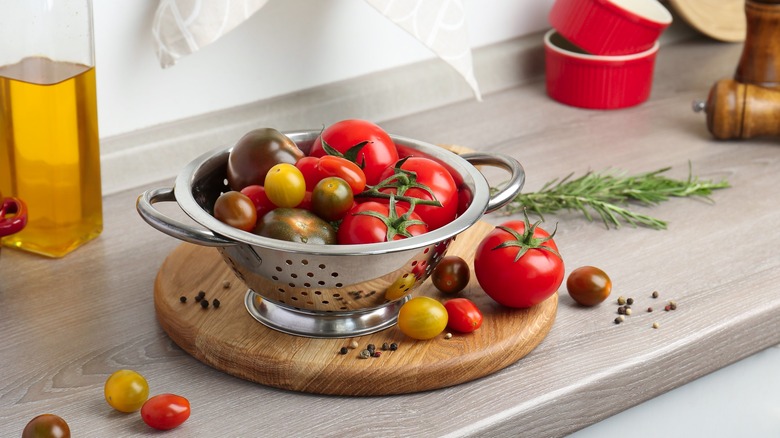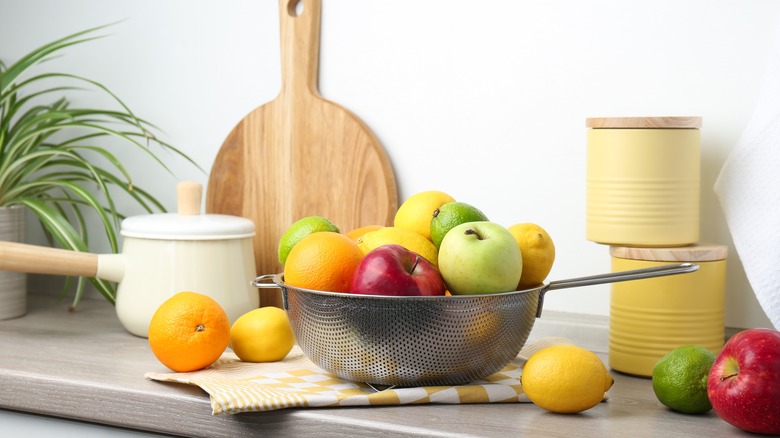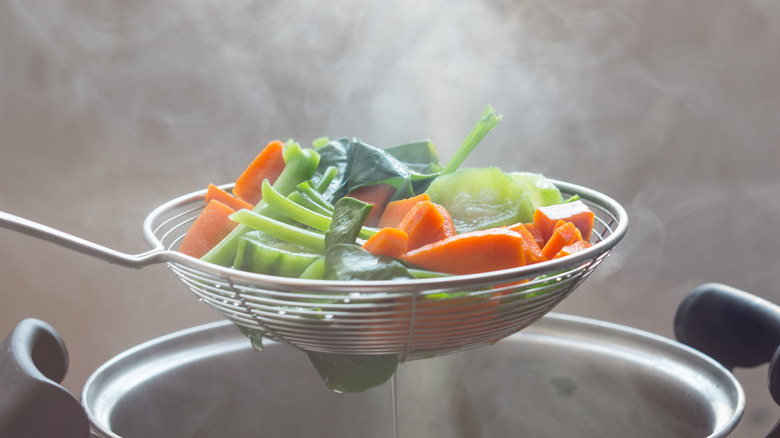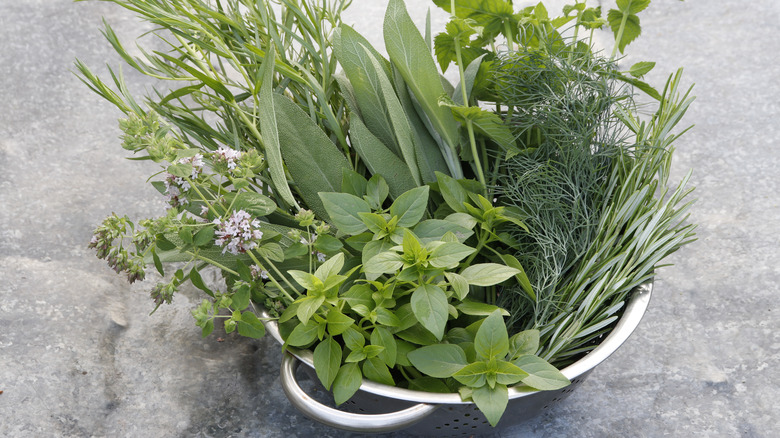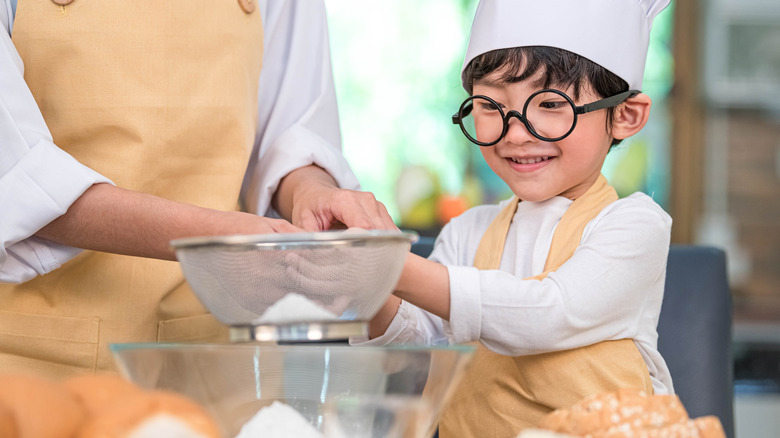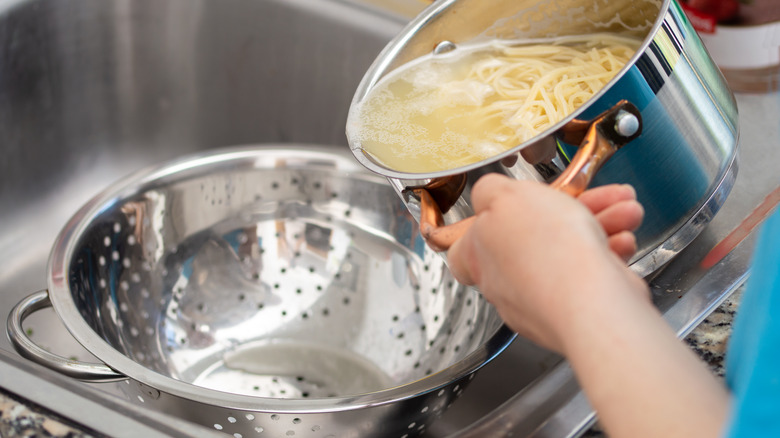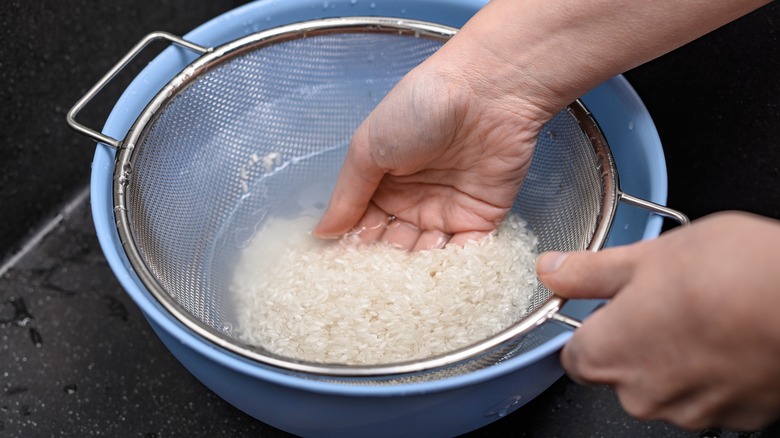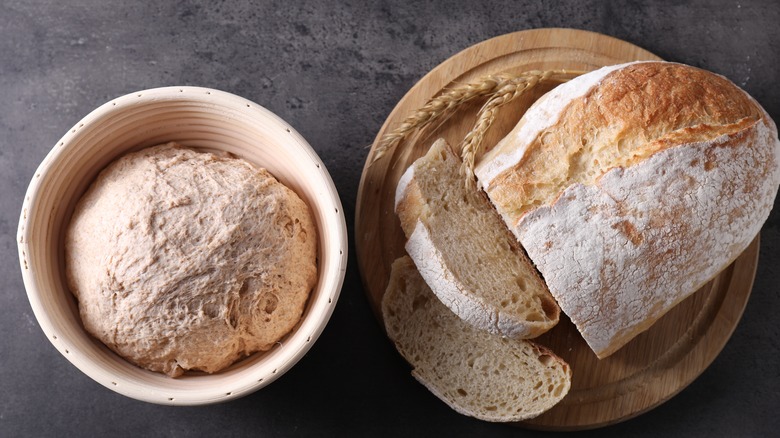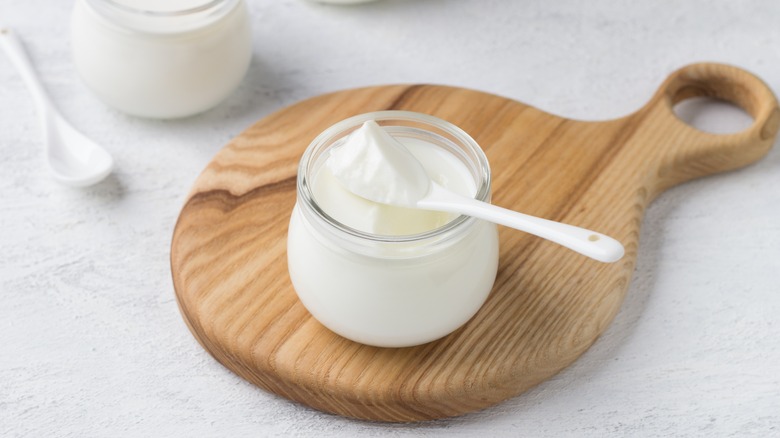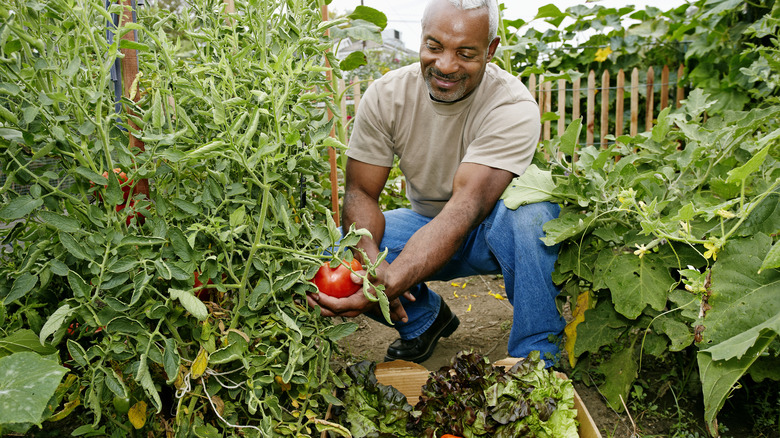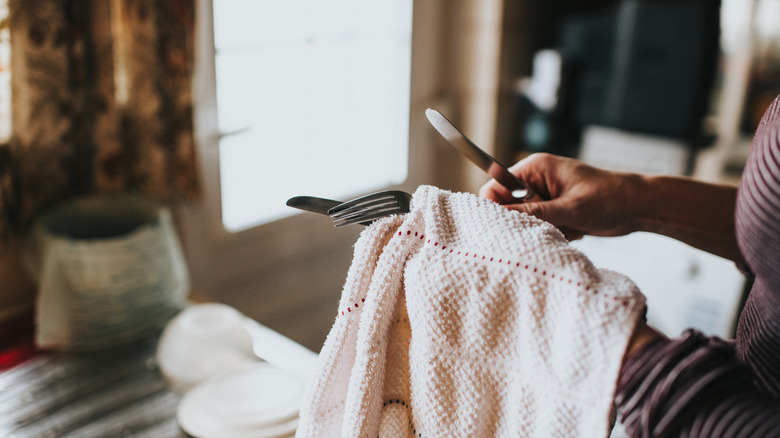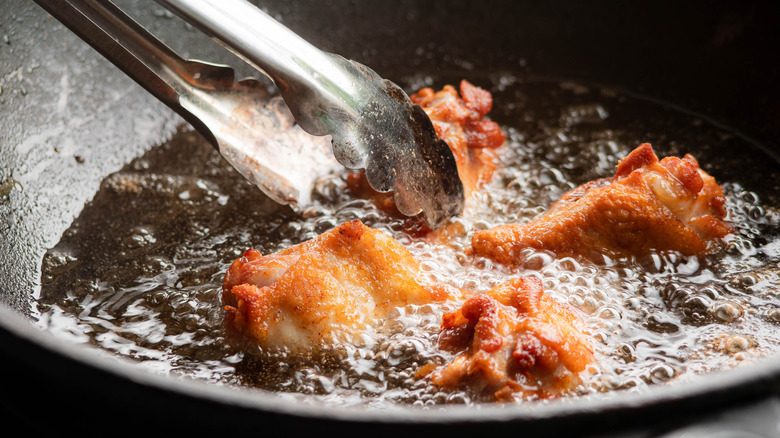12 Ways To Use A Colander You've Probably Never Thought Of
Take a look at your kitchen and strip it bare of all the single-purpose kitchen gadgets it has undoubtedly collected over the years. Which tools could you really not go without? The first few to come to mind are likely your knives, pans, and utensils. These kitchen tools are essential, yes, but they still pretty much serve a single purpose. The colander, on the other hand, may not initially catch your eye. But it is actually the unsung hero of the kitchen. It is obviously great at straining and separating, but one of the biggest mistakes you can make when using a colander is not recognizing its full potential. In fact, the colander could replace many of those niche kitchen tools currently taking up space in your kitchen cabinets.
To uncover the full potential of the colander, we spoke to Bri Bell, founder of Frugal Minimalist Kitchen. She's a pro at finding ways to simplify the cooking process and creating a minimalist kitchen. We also turned to a large Facebook group with almost 300,000 members, The Minimalist Life, to crowdsource unique uses for the colander. We received responses from people of all adult generations who follow a "have less, use more" kind of lifestyle. It's our hope that you find these alternative uses for the colander to be practical and you use them to make life a little easier.
1. Replace your fruit bowl with a colander
They make some pretty aesthetic colanders these days, and using one on your kitchen countertops for your fruit could serve a dual purpose. A colander is basically just a bowl with holes, so it may seem an obvious choice to use it as such. Sometimes the simplest use is one of the best, because using a colander as a fruit bowl has a few advantages.
Replacing your fruit bowl with a colander can increase airflow to your fruit. This will help to keep your produce fresh longer. Because your fruit is keeping longer, you'll likely see a decrease in those pesky fruit flies you've surely noticed sticking around on warmer days. Fruit flies love to land on ripening and rotten fruit, where they lay their eggs. Pro tip: stick the colander with fruit in the fridge, as this can extend the life of the fruit even more (though it can also slow down the ripening process).
One downside to this use is that you'll likely need to keep an additional colander in your kitchen. That is, unless you want to empty out your fruit bowl every time you need a colander to serve its original function. Though it could mean that another bonus is that when your home is fruitless, you don't have an empty fruit bowl on the counter calling you out on your lack of an entire food group.
2. Steam veggies and other food with a metal colander
A lot of basic kitchens do not have a steamer basket, but they do have a trusty colander. If your colander is metal, you'll never need to add a steamer basket to the many gadgets your kitchen probably already has lying around. With very little finagling, your metal colander can act almost exactly like a steamer basket and cook veggies or other steam-able food to perfection.
All you need to do is place the veggies you'd like to steam in your colander, find a pot that is slightly larger in diameter than your steamer, and bring an inch or two of water to boil. Place the veggie-filled colander in the pot, being careful to keep if from touching the boiling water, and you're cooking.
One potential issue of using a colander as a steaming basket that may be a bit of an inconvenience is the lid. You can use the lid to the pot you are cooking with, but it's not going to be a perfect fit for your colander. Using a lid that is either too big or too small typically isn't that much of a problem, but do be mindful that glass lids have a small change of breakage if it is too big for the colander. You'll also want to be mindful of any hot steam that may be escaping when you go to check on your food.
3. Pluck and strip herbs with a colander
Probably one of the most surprising and useful tricks hidden up a colander's metaphorical sleeve is that it can be used to strip herbs. Cilantro, rosemary, parsley, or just about any other herb with a stem can be plucked and stripped with a simple pass through a colander. Minimalist cooking expert Bri Bell explained how she replaced an herb stripper with her own colander. "You can use the holes of a colander to strip the leaves off of fresh herbs instead of using a dedicated herb stripper," she said. "Simply poke the stem through one of the holes and pull. The leaves will cleanly come off the stem and be collected in the colander, ready to rinse!"
In order for this easy herb stripping hack to work, the herbs you are using must be relatively fresh. Wilted herbs will be more likely to succumb to the colander's holes when pulled through. Stronger, stiffer herbs will be pulled taut and will more easily lose their leaves when passing through the colander's holes. The herbs must start on the inside or internal wall of the colander and come out on the outside for this trick to work properly. This is the only way your herbs will be caught all together rather than being scattered all over the work area.
4. Sift together dry ingredients
When baking, it can sometimes be incredibly important to find a sifter. You may need to sift your dry ingredients together or send your flour and powdered sugar through a sifter to even out any lumps before mixing with liquid ingredients. Sifting helps to add air into your dry ingredients, which makes them mix more evenly when added to wet ingredients. This avoids pockets of unmixed flour in your batter and clumps in your finished baked goods. But products specifically marketed as sifters are really often just glorified colanders that can be replaced quite easily with a fine mesh colander.
Colanders with larger holes can still be used, just to less effect. The larger holes will still help get rid of clumps and separate more finicky dry ingredients, but you may need to sift less at a time. Whatever form you use, shake the colander back and forth swiftly to break up the ingredients into smaller pieces. These small pieces will cascade down from the colander and into a clean bowl positioned below. If you only have a large grained colander, use an additional bowl to repeat your sifting so that the dry ingredients have a few passes through the colander. You can also pair your colander with a whisk, whisking the flour up top to both help break it up and gently push it through the holes.
5. Separate cooked foods from liquid
You've likely used your colander to separate your cooked pasta noodles from the water they were boiled in, but the colander's separation skills don't end there. A colander can be used to separate any solid from a liquid, so there's not really a limit to how many dishes the tool can help prepare. Our consulting expert Bri Bell personally has used her colander for a number of things. "I use it to drain cooked foods like boiled pasta, perogies, potatoes, or other vegetables," she told Mashed. Pro tip: boiled potatoes can be mashed directly in the colander after draining the water, just do so over a bowl instead of the sink.
This food separation use for a colander can be a lifesaver for parents of young children as well. Have a finicky toddler who didn't like their pasta sauce? Throw their dish in a colander and rinse away the sauce. You're left with the noodles that you can then butter and sprinkle parmesan over, crisis averted. This works if there is just too much sauce on a dish or broth in a soup as well, just skip the rinsing part.
6. Rinsing grains is made easy with a colander
Do you rinse your grains before you cook them? You probably should! Grains like farro, quinoa, and many types of rice all should be rinsed in cold water prior to cooking. This removes any other materials from the rice that have been overlooked when processed, any additives, and also gets rid of excess starch that can sometimes dramatically affect a final dish. A colander is the ideal tool to rinse grains, but requires a process that's a little different than simply rinsing other foods like veggies and pasta.
To rinse your grains, place a small grained colander in the bowl of water before adding the grains to the colander. Swirl them around with your fingers or by moving the colander in a smooth, circular motion. The movement should get the grains moving, but not so much that they float out of the colander. Lift the grain filled colander and dump the water, repeating this until the water remains clear.
Instead of this bowl method, you could hold the colander under a running faucet. Once the water runs through the grains clear, you're ready to start cooking. Either way, a colander is a vital tool in this process.
7. Proof your sourdough in a colander
Sourdough is all the rage now, to the point where you can find kits that attempt to sell you all sorts of specialized gadgets for bread making. As daunting as sourdough may seem, however, you actually don't need many extras when it comes baking bread. Indeed, you can find alternatives to some of these niche tools already in your kitchen. According to multiple members of The Minimalist Life group we crowdsourced, a colander can easily replace a proofing bowl or banneton. The only real difference between the two is that a colander will leave a dotted pattern instead of the circular impression bannetons are known for.
The colander's holes serve a much more important purpose than just leaving a pattern, though. Air is able to get to the underside of the sourdough while it's proofing in a colander. This aeration is important for the maturation of the yeast and as such a colander may be an even better vessel for proofing sourdough than a banneton basket.
One downside of this is that if you have a more malleable dough, it could slide through the holes. This is easily fixed by lining the colander with a tea towel, similar to how breadmakers already use a banneton. Another possible negative is that you would be without your colander for the time it takes to proof your bread, which could be as long as a couple days. The solution here would be to buy an additional colander.
8. Colanders make decent snack bowls
It may sometimes seem as if half a generation's popcorn bowl doubled as the family's occasional sick bowl. It's a new age, so let's allow the biggest bowl to be its own separate entity and start snacking with a colander. The colander is great as a snack bowl because the kitchen tool is typically larger than your average eating bowl, and much lighter than a large bowl.
Popcorn, chips, and other snacks with a diameter larger than a dime are great for the colander. The smaller the grain on your colander, the smaller snacks you'll be able to successfully munch on straight out of this colander/bowl hybrid. For extra security, you can line the colander with a tea towel (that's extra useful for anything dusted with flavorings).
Larger holes do serve a nice purpose when using a colander for a snack bowl, especially if we're talking about popcorn. Never again will you reach the bottom of the bowl and be met with the taunts of loose kernels that failed to pop, at least assuming the colander has the right-sized holes. Just give the colander a few gentle shakes over a trash can and you'll be kernel free! This works well for managing chip and pretzel crumbs, too.
9. Make homemade yogurt with the aid of a colander
Colanders are vital in kitchens, especially in homestead or from-scratch kitchens. When cooking or baking from the ground up, you will quickly learn that you often need a strainer or colander. To that end, The Minimalist Life member Maria Williams suggested in our crowdsourcing thread that colanders were great for making homemade yogurt. According to her, simply lining a colander with cheesecloth is the ideal way to strain the freshly made yogurt.
This is all because fresh yogurt needs the whey strained off (unless you like your yogurt to be especially loose). This whey is the thin, watery part that separates from the more solid yogurt. Straining it off not only makes the yogurt thicker, but decreases the amount of lactose in the final product. However, you'll probably need one more piece of equipment to make this work. Unless you have a colander with a very small grain, you will need a cheesecloth or coffee filter to insure the yogurt doesn't get strained away with the whey. You can use this same method to thicken up store bought yogurt.
10. Take your colander to the garden as a harvesting basket
Your colander is vital in the kitchen, but the useful kitchen tool can be used outside of the kitchen as well. When we asked our expert Bri Bell where she likes to take her colander, she directed us straight to the garden. "I've used it as a basket for picking garden produce. Then it's easy to rinse off your food without dirtying another dish," she explained.
Most gardeners might use a crate or basket for their abundant harvest, but a colander could actually be a step up for more reasons than one. First, as Bell explained, it allows you to immediately rinse off your bountiful harvest. This way, your veggies are not sitting idle in a basket. Plus, if they're taking up one of your kitchen tools, you're likely to feel more obligated to put them away immediately.
Second, if you happen to be harvesting in the morning or after a rain, your veggies may be a bit wet. Your colander is built to handle moisture, whereas baskets and wooden storage are typically not. In other words, if you are harvesting wet produce in a basket and don't get around to drying and putting it away promptly, you may end up with mold growth that ruins your fruits and veggies. Moldy baskets should get tossed and then you'll be looking for an alternative way to harvest anyway — skip the hassle and just use a colander from the beginning.
11. Handwashing silverware is made easier with a colander
Dishwashers are nothing less than a game changer in the kitchen, but some things are just better when washed by hand. Colanders and nice silverware easily fall in this hand washing category. If you regularly wash your regular silverware by hand, too, you've likely known the frustration of washing and rinsing each piece separately. Cleaning between the holes of the colander, especially when they're fine grained, is a totally different hurdle. Washing the two kitchen essentials together can make cleaning both quite a lot easier.
After you rinse to get off any large debris, place all the soiled silverware in the colander. Add a little bit of soap and give it a little shake, almost as if you are panning for gold. Repeat this until the soap is gone and you've got clean silverware!
This method is essentially how it is done in a lot of restaurants, though on a much smaller scale. Restaurants typically place all their silverware in a tray with drainage holes and send it through the dishwasher, sometimes twice to get as especially stuck-on particles. By adopting this must-know kitchen cleaning hack, you'll save time and create a more efficient kitchen.
12. Keep your kitchen splatter free with a makeshift grease guard
Kitchens are designed to handle messes, but surely most people would like to spend more time cooking than cleaning. Yet this can be a difficult balance to maintain, especially when you're frying on the stovetop. Though there are a few ways to reduce oil splatter in the first place, a colander can help eliminate the grease splatters that do occur when frying.
A colander can act as a makeshift grease guard, eliminating the need for one in a home kitchen entirely. It's as simple as placing your colander over the pot you're cooking with to keep hot grease from splattering all over your kitchen. Be sure to use metal, as a plastic colander could melt when faced with the heat. Even if the plastic doesn't noticeably melt, the heat can imperceptibly leach plastic into your food.
This hack is twofold, because when you're done cooking, you can use the soiled colander as a grease strainer. If you store bacon or any other kind of grease in a jar for future use, use the colander to separate large fried food particles from the liquid.
